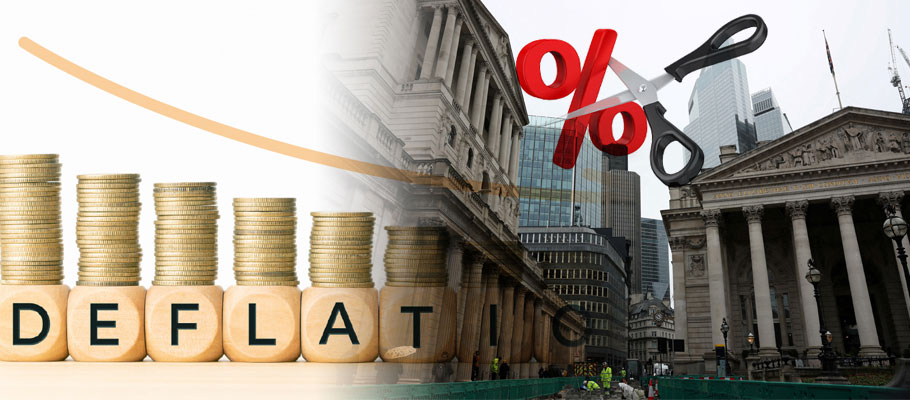
Published: May 8th, 2024
New data from the British Retail Consortium (BRC) says prices on UK high streets have stabilized as a disinflation trend took hold in April, raising the possibility that Bank of England (BoE) policymakers might soon have justification to cut interest rates.
The BRC's Shop Price Index tracks retail inflation trends. In April 2024 it said annual UK inflation fell to 0.8 per cent in April, a reduction from 1.3 per cent the previous month and under the three-month average of 1.4 per cent.
An analysis by NielsenIQ said annual growth in food prices had sunk to its lowest level since December 2021. Food inflation slowed to 3.4 per cent in April, falling slightly from 3.7 per cent in March. That was also under three three-month average rate of 3.9 per cent and marked the 11th weekly reduction in food price increases.
The pace of price rises in fresh food also slowed in April, falling to 2.4 per cent from 2.6 per cent in March and under the three-month average of 2.7 per cent.
The direction of travel in retail prices will lift hopes the Bank of England can soon cut interest rates. Markets expect April’s headline CPI inflation figure will have dipped below 2.0%, which will show up in May's official inflation release.
While those trends might raise expectations for a BoE rate cut, UK services inflation is still running hot at around six per cent. Consensus is also looking for inflation to rise again above Threadneedle Street’s two per cent target later in the year.
Meanwhile other core measures are stubbornly above the two per cent threshold. Until a consistent and sustainable move in headline inflation brings it below two per cent, bank policymakers are unlikely to budge.
Inflation was definitive for GBP’s fortunes back in January 2022 when a strong start to the year gained further support from inflation figures that came in above market expectations, plus a growing consensus amongst economists that other inflation surges were imminent.
British CPI inflation for December 2021 was 5.3 per cent year-on-year according to the UK’s Office for National Statistics (ONS), ahead of expectations for a reading of 5.1 per cent and exceeding the previous month’s 5.0 per cent.
Core CPI came in at 4.1 per cent, well in excess of the market's expectation for 3.8 per cent.
The surprise figures and the core CPI reading, in particular, put pressure on the Bank of England to take action. With a longstanding inflation target of 2.0 per cent, forex traders were beginning to bet on a February rate hike.
‘A rate rise next month (March 2022) now looks to be on the cards from the BoE,’ said CMC Markets in an analyst note. Inflationary pressures are so intense that CPI is now exceeding Threadneedle Street's target by more than it has at any point since 1993, the year the bank first established an inflation target.
It all made for a supportive backdrop for sterling bulls. The GBP/EUR exchange rate pushed above 1.19 on Tuesday 25th January 2022, while GBP/USD was up slightly on the previous day at 1.3589.
The BoE lifted rates on 16th December 2021 on worries that UK inflation might be stuck above the central bank’s two per cent target, raising prospects for another rate rise in March 2022.
A growing chorus of economists believed the Bank Rate would go as high as 1.24 per cent by year-end 2022.
Strategists at Barclays FX said an 'aggressive' shift in expectations for higher rates meant that sterling had already hit the levels of appreciation forecast by the bank for the first half of 2022. In a market analysis, they wrote that the extent of pound appreciation from Q4 of 2021 onward suggested traders should be cautious about chasing additional near-term gains.
But other currency strategists saw Sterling potentially leaping further ahead in 2022 amid a mix of strong employment figures, high inflation, and a central bank prone to take more aggressive action on rates than it had through the pandemic.
According to ONS figures, the most significant sector contributors to December 2021’s high inflation reading were food and non-alcoholic beverages, furniture, transport, housing, and household goods.
It suggested that the pressure on British prices was widespread, pointing to price rises driven by external factors that Threadneedle Street couldn’t afford to ignore.
Barclay's was looking for a 25-basis point lift following the February Bank of England policy meeting. In their view, it would support further GBP rises. Inflation, meanwhile, probably hasn’t peaked yet.
Economists at ING in London told The Financial Times that rising inflation 'has some mileage left in it yet.
'While we can expect it to peak in the coming months, especially if the energy price cap is removed by Westminster as planned, markets also have to price in the impact of a cost-of-living crunch'. With prices rising and real wages falling, households might rein-in spending, something sure to impact economic growth.
In response to the high inflation figures, UK Chancellor of the Exchequer Rishi Sunak said in a press release that the government 'understands the pressures ordinary people are dealing with due to pandemic-driven price rises.'
Analysts wre warning that a cost-of-living crisis could be triggered if Westminster goes ahead with planned tax increases this year, which include a hike to the monthly National Insurance levy paid by all Britons. It’s set to rise in April.
A commentary published by the UK Confederation for British Industry (CBI) said that it's now 'urgent for the Government to develop solutions that will shield the most vulnerable consumers from further expected price rises'.
Solutions also must be found for businesses buckling under the weight of rising costs for materials and essential overheads like energy. The CBI also says that Westminster needs to develop a long-term strategy to manage the impact of energy market reforms and protect businesses from future energy price volatility.